Analyzing Cultural Diversity Challenges at Sainsbury Company
VerifiedAdded on 2023/01/09
|10
|2616
|38
Project
AI Summary
This research project critically examines the potential problems related to cultural diversity within Sainsbury's, a major UK supermarket chain, and how it influences operational performance and productivity. The project aims to determine the importance of cultural diversity, identify associated problems and challenges, and explore measures to minimize negative impacts. The study reviews existing literature on workplace diversity, emphasizing the benefits of diverse teams, the challenges of cultural and generational differences, and the importance of inclusive policies and training. The methodology involves qualitative research using interviews with Sainsbury's employees and thematic analysis to interpret data. The research considers ethical aspects and aims to provide insights into improving cultural diversity within the company.

Research project
Paraphrase This Document
Need a fresh take? Get an instant paraphrase of this document with our AI Paraphraser
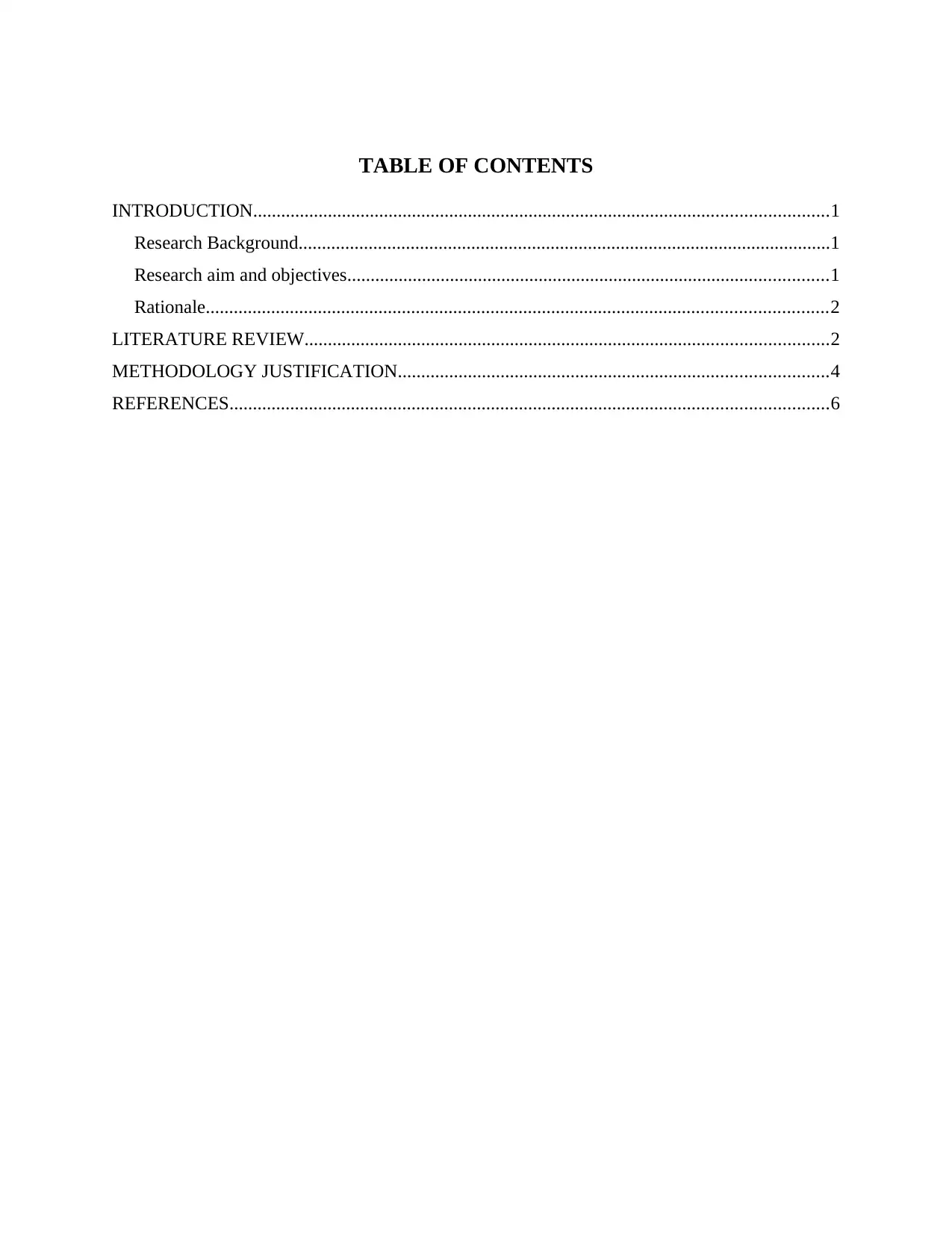
TABLE OF CONTENTS
INTRODUCTION...........................................................................................................................1
Research Background..................................................................................................................1
Research aim and objectives.......................................................................................................1
Rationale.....................................................................................................................................2
LITERATURE REVIEW................................................................................................................2
METHODOLOGY JUSTIFICATION............................................................................................4
REFERENCES................................................................................................................................6
INTRODUCTION...........................................................................................................................1
Research Background..................................................................................................................1
Research aim and objectives.......................................................................................................1
Rationale.....................................................................................................................................2
LITERATURE REVIEW................................................................................................................2
METHODOLOGY JUSTIFICATION............................................................................................4
REFERENCES................................................................................................................................6

INTRODUCTION
Research Background
Workplace diversity is one of the key significant measure where the employees who
belong to diverse culture, race, caste, religion, nationality, ethnicity, etc. The organization who
tends to have workplace diversity leads to wide set of experience among the employees (How
to Build, Manage and Promote Workplace Diversity?, 2018). The diversity within
the organization is highly significant in boosting up the reputation of the brand and leads to
increased degree of performance, creativity and productivity (Mousa, Massoud, and Ayoubi,
2020). This is useful in the creation of the global impact and helps in positioning the business
within the market. This study will significantly focus on effectively carrying out the critical
examination of the potential problems related with cultural diversity within the organization and
how it influence operational performance and productivity. This study also tends to focus on
determining the measures which can be taken in order to effectively minimize the negative
impact of cultural diversity. Sainsbury Company is considered to be one of the second largest
company chain related with the supermarkets in UK. This company was founded in the 1869 and
has been significantly founded by John James Sainsbury. This is one of the largest retailer
company. This company mainly deals in superstore, convenience shop, hypermarket, and
supermarket and forecourt shop.
Research aim and objectives
Research Aim
“To critically examine the potential problems related with cultural diversity within the
organization and how it influence operational performance and productivity. A study on
Sainsbury Company.”
Research Objectives
To determine the importance of the cultural diversity within company.
To examine the problems related with cultural diversity within the employees of
company.
To determine the key challenges to impose cultural diversity within the company.
To examine the measures which can be taken in order to effectively minimize the
negative impact of cultural diversity.
Research Questions
1
Research Background
Workplace diversity is one of the key significant measure where the employees who
belong to diverse culture, race, caste, religion, nationality, ethnicity, etc. The organization who
tends to have workplace diversity leads to wide set of experience among the employees (How
to Build, Manage and Promote Workplace Diversity?, 2018). The diversity within
the organization is highly significant in boosting up the reputation of the brand and leads to
increased degree of performance, creativity and productivity (Mousa, Massoud, and Ayoubi,
2020). This is useful in the creation of the global impact and helps in positioning the business
within the market. This study will significantly focus on effectively carrying out the critical
examination of the potential problems related with cultural diversity within the organization and
how it influence operational performance and productivity. This study also tends to focus on
determining the measures which can be taken in order to effectively minimize the negative
impact of cultural diversity. Sainsbury Company is considered to be one of the second largest
company chain related with the supermarkets in UK. This company was founded in the 1869 and
has been significantly founded by John James Sainsbury. This is one of the largest retailer
company. This company mainly deals in superstore, convenience shop, hypermarket, and
supermarket and forecourt shop.
Research aim and objectives
Research Aim
“To critically examine the potential problems related with cultural diversity within the
organization and how it influence operational performance and productivity. A study on
Sainsbury Company.”
Research Objectives
To determine the importance of the cultural diversity within company.
To examine the problems related with cultural diversity within the employees of
company.
To determine the key challenges to impose cultural diversity within the company.
To examine the measures which can be taken in order to effectively minimize the
negative impact of cultural diversity.
Research Questions
1
⊘ This is a preview!⊘
Do you want full access?
Subscribe today to unlock all pages.

Trusted by 1+ million students worldwide

What is the importance of the cultural diversity within company?
What are the problems related with cultural diversity within the employees of company?
What are the key challenges associated with imposing cultural diversity within the
company?
What are the measures which can be taken in order to effectively minimize the negative
impact of cultural diversity?
Rationale
One of the key relevant reason for carrying out the study is that it is one of the wide topic
which helps the researcher in critically examining the potential problems related with cultural
diversity within the organization. This is useful for the researcher to gain wide set of in- depth
analysis related with the study. Moreover, the researcher also focuses on carrying out the study
on this subject matter because of the academic interest to research regarding the specific subject
matter. The researcher will also carry out the study on this because of the own personal interest
and interview people to gain valid insights on the subject matter.
LITERATURE REVIEW
To determine the importance of the cultural diversity within company.
Tompos. and Ablonczy-Mihályka, (2018) sought to determine the fact that, the cultural
diversity mainly comprises of diverse group of people on the basis of religion, ethnicity, gender,
sex, nationality, race, qualification, knowledge, et cetera within the organisation. Diverse culture
is useful in understanding varied perspective of the different employees within the company
from across the globe. It is very useful and dispelling negative stereotypes and also personal
biases among different group of people within the organisation. Subsequently, Lambert, (2016)
argued that, the cultural diversity within the organisation is very useful because it helps in
respecting and also recognising various culture of the individual from across the globe. Diverse
culture has different ways of thinking which eventually leads to analysing different matter in a
relevant and significant manner. In order to promote diversity within the organisation it is useful
to build teams which are of diverse groups and helps in taking decision accordingly. Practising
good manners and respect each other’s culture is highly prominent which eventually leads to
better performance and productivity within the workplace. Kamales, and Knorr, (2019) examined
the fact that, cultural diversity within the workplace organisation is considered to be highly
relevant in significantly inspiring creativity and also driving innovation within the organisation.
2
What are the problems related with cultural diversity within the employees of company?
What are the key challenges associated with imposing cultural diversity within the
company?
What are the measures which can be taken in order to effectively minimize the negative
impact of cultural diversity?
Rationale
One of the key relevant reason for carrying out the study is that it is one of the wide topic
which helps the researcher in critically examining the potential problems related with cultural
diversity within the organization. This is useful for the researcher to gain wide set of in- depth
analysis related with the study. Moreover, the researcher also focuses on carrying out the study
on this subject matter because of the academic interest to research regarding the specific subject
matter. The researcher will also carry out the study on this because of the own personal interest
and interview people to gain valid insights on the subject matter.
LITERATURE REVIEW
To determine the importance of the cultural diversity within company.
Tompos. and Ablonczy-Mihályka, (2018) sought to determine the fact that, the cultural
diversity mainly comprises of diverse group of people on the basis of religion, ethnicity, gender,
sex, nationality, race, qualification, knowledge, et cetera within the organisation. Diverse culture
is useful in understanding varied perspective of the different employees within the company
from across the globe. It is very useful and dispelling negative stereotypes and also personal
biases among different group of people within the organisation. Subsequently, Lambert, (2016)
argued that, the cultural diversity within the organisation is very useful because it helps in
respecting and also recognising various culture of the individual from across the globe. Diverse
culture has different ways of thinking which eventually leads to analysing different matter in a
relevant and significant manner. In order to promote diversity within the organisation it is useful
to build teams which are of diverse groups and helps in taking decision accordingly. Practising
good manners and respect each other’s culture is highly prominent which eventually leads to
better performance and productivity within the workplace. Kamales, and Knorr, (2019) examined
the fact that, cultural diversity within the workplace organisation is considered to be highly
relevant in significantly inspiring creativity and also driving innovation within the organisation.
2
Paraphrase This Document
Need a fresh take? Get an instant paraphrase of this document with our AI Paraphraser
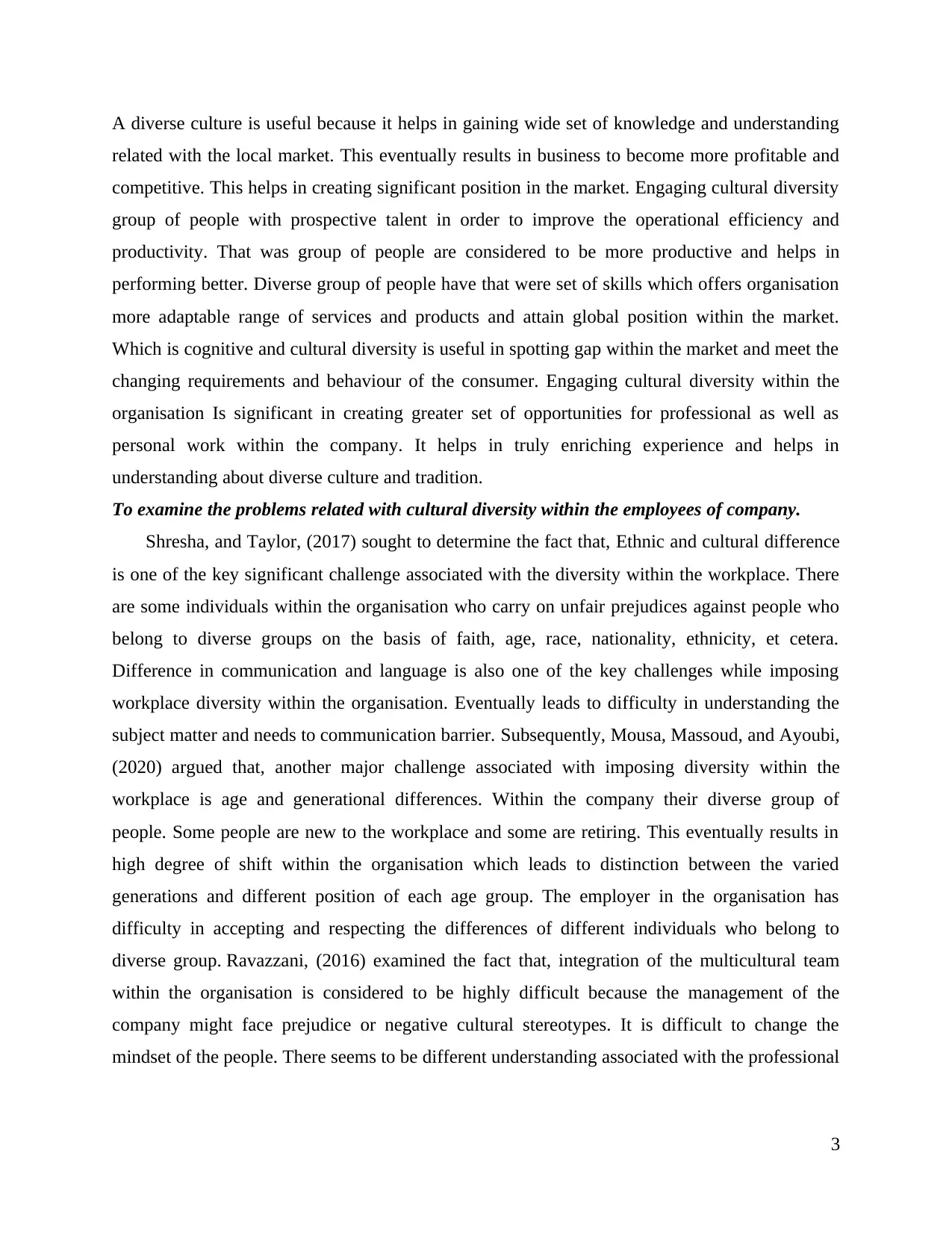
A diverse culture is useful because it helps in gaining wide set of knowledge and understanding
related with the local market. This eventually results in business to become more profitable and
competitive. This helps in creating significant position in the market. Engaging cultural diversity
group of people with prospective talent in order to improve the operational efficiency and
productivity. That was group of people are considered to be more productive and helps in
performing better. Diverse group of people have that were set of skills which offers organisation
more adaptable range of services and products and attain global position within the market.
Which is cognitive and cultural diversity is useful in spotting gap within the market and meet the
changing requirements and behaviour of the consumer. Engaging cultural diversity within the
organisation Is significant in creating greater set of opportunities for professional as well as
personal work within the company. It helps in truly enriching experience and helps in
understanding about diverse culture and tradition.
To examine the problems related with cultural diversity within the employees of company.
Shresha, and Taylor, (2017) sought to determine the fact that, Ethnic and cultural difference
is one of the key significant challenge associated with the diversity within the workplace. There
are some individuals within the organisation who carry on unfair prejudices against people who
belong to diverse groups on the basis of faith, age, race, nationality, ethnicity, et cetera.
Difference in communication and language is also one of the key challenges while imposing
workplace diversity within the organisation. Eventually leads to difficulty in understanding the
subject matter and needs to communication barrier. Subsequently, Mousa, Massoud, and Ayoubi,
(2020) argued that, another major challenge associated with imposing diversity within the
workplace is age and generational differences. Within the company their diverse group of
people. Some people are new to the workplace and some are retiring. This eventually results in
high degree of shift within the organisation which leads to distinction between the varied
generations and different position of each age group. The employer in the organisation has
difficulty in accepting and respecting the differences of different individuals who belong to
diverse group. Ravazzani, (2016) examined the fact that, integration of the multicultural team
within the organisation is considered to be highly difficult because the management of the
company might face prejudice or negative cultural stereotypes. It is difficult to change the
mindset of the people. There seems to be different understanding associated with the professional
3
related with the local market. This eventually results in business to become more profitable and
competitive. This helps in creating significant position in the market. Engaging cultural diversity
group of people with prospective talent in order to improve the operational efficiency and
productivity. That was group of people are considered to be more productive and helps in
performing better. Diverse group of people have that were set of skills which offers organisation
more adaptable range of services and products and attain global position within the market.
Which is cognitive and cultural diversity is useful in spotting gap within the market and meet the
changing requirements and behaviour of the consumer. Engaging cultural diversity within the
organisation Is significant in creating greater set of opportunities for professional as well as
personal work within the company. It helps in truly enriching experience and helps in
understanding about diverse culture and tradition.
To examine the problems related with cultural diversity within the employees of company.
Shresha, and Taylor, (2017) sought to determine the fact that, Ethnic and cultural difference
is one of the key significant challenge associated with the diversity within the workplace. There
are some individuals within the organisation who carry on unfair prejudices against people who
belong to diverse groups on the basis of faith, age, race, nationality, ethnicity, et cetera.
Difference in communication and language is also one of the key challenges while imposing
workplace diversity within the organisation. Eventually leads to difficulty in understanding the
subject matter and needs to communication barrier. Subsequently, Mousa, Massoud, and Ayoubi,
(2020) argued that, another major challenge associated with imposing diversity within the
workplace is age and generational differences. Within the company their diverse group of
people. Some people are new to the workplace and some are retiring. This eventually results in
high degree of shift within the organisation which leads to distinction between the varied
generations and different position of each age group. The employer in the organisation has
difficulty in accepting and respecting the differences of different individuals who belong to
diverse group. Ravazzani, (2016) examined the fact that, integration of the multicultural team
within the organisation is considered to be highly difficult because the management of the
company might face prejudice or negative cultural stereotypes. It is difficult to change the
mindset of the people. There seems to be different understanding associated with the professional
3
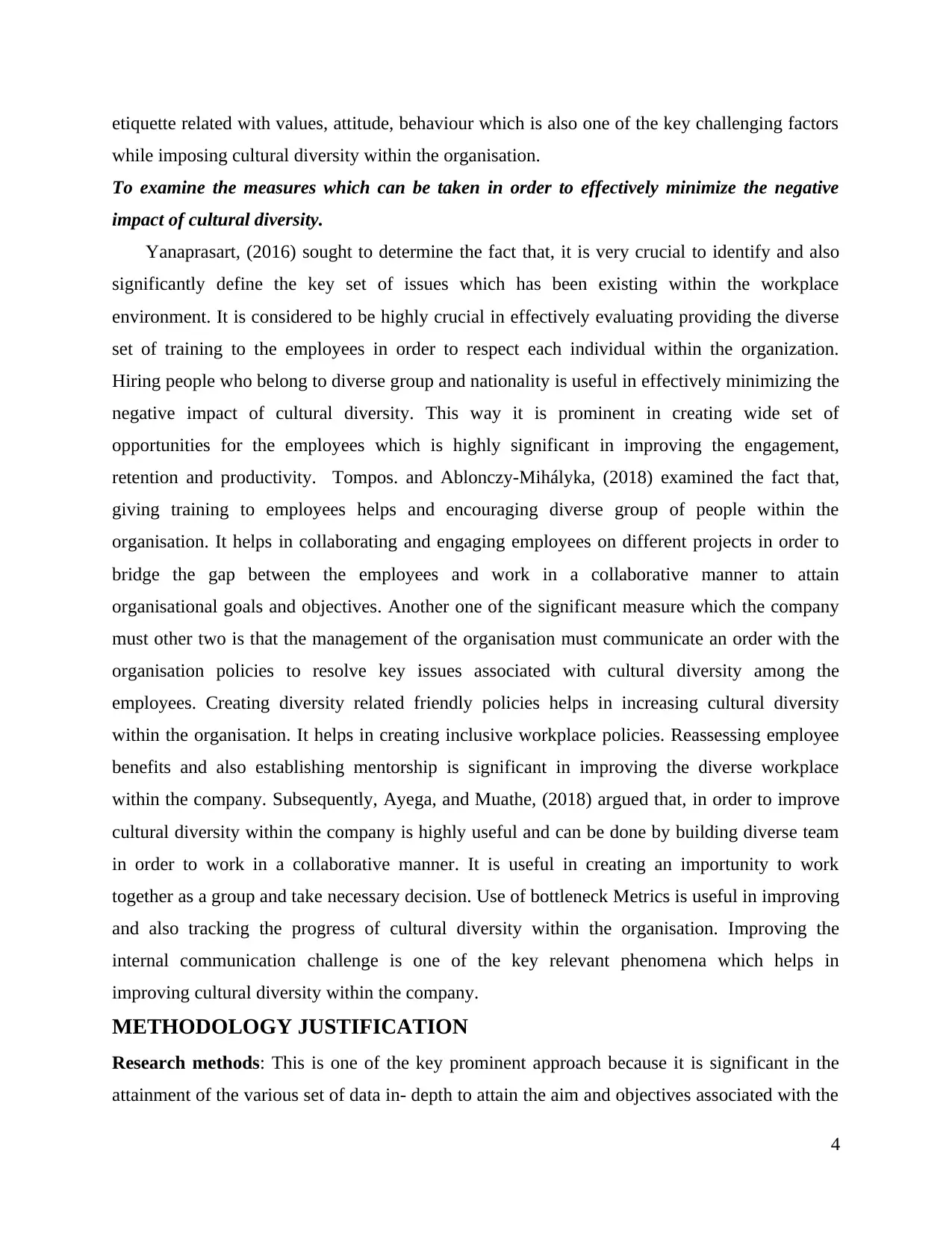
etiquette related with values, attitude, behaviour which is also one of the key challenging factors
while imposing cultural diversity within the organisation.
To examine the measures which can be taken in order to effectively minimize the negative
impact of cultural diversity.
Yanaprasart, (2016) sought to determine the fact that, it is very crucial to identify and also
significantly define the key set of issues which has been existing within the workplace
environment. It is considered to be highly crucial in effectively evaluating providing the diverse
set of training to the employees in order to respect each individual within the organization.
Hiring people who belong to diverse group and nationality is useful in effectively minimizing the
negative impact of cultural diversity. This way it is prominent in creating wide set of
opportunities for the employees which is highly significant in improving the engagement,
retention and productivity. Tompos. and Ablonczy-Mihályka, (2018) examined the fact that,
giving training to employees helps and encouraging diverse group of people within the
organisation. It helps in collaborating and engaging employees on different projects in order to
bridge the gap between the employees and work in a collaborative manner to attain
organisational goals and objectives. Another one of the significant measure which the company
must other two is that the management of the organisation must communicate an order with the
organisation policies to resolve key issues associated with cultural diversity among the
employees. Creating diversity related friendly policies helps in increasing cultural diversity
within the organisation. It helps in creating inclusive workplace policies. Reassessing employee
benefits and also establishing mentorship is significant in improving the diverse workplace
within the company. Subsequently, Ayega, and Muathe, (2018) argued that, in order to improve
cultural diversity within the company is highly useful and can be done by building diverse team
in order to work in a collaborative manner. It is useful in creating an importunity to work
together as a group and take necessary decision. Use of bottleneck Metrics is useful in improving
and also tracking the progress of cultural diversity within the organisation. Improving the
internal communication challenge is one of the key relevant phenomena which helps in
improving cultural diversity within the company.
METHODOLOGY JUSTIFICATION
Research methods: This is one of the key prominent approach because it is significant in the
attainment of the various set of data in- depth to attain the aim and objectives associated with the
4
while imposing cultural diversity within the organisation.
To examine the measures which can be taken in order to effectively minimize the negative
impact of cultural diversity.
Yanaprasart, (2016) sought to determine the fact that, it is very crucial to identify and also
significantly define the key set of issues which has been existing within the workplace
environment. It is considered to be highly crucial in effectively evaluating providing the diverse
set of training to the employees in order to respect each individual within the organization.
Hiring people who belong to diverse group and nationality is useful in effectively minimizing the
negative impact of cultural diversity. This way it is prominent in creating wide set of
opportunities for the employees which is highly significant in improving the engagement,
retention and productivity. Tompos. and Ablonczy-Mihályka, (2018) examined the fact that,
giving training to employees helps and encouraging diverse group of people within the
organisation. It helps in collaborating and engaging employees on different projects in order to
bridge the gap between the employees and work in a collaborative manner to attain
organisational goals and objectives. Another one of the significant measure which the company
must other two is that the management of the organisation must communicate an order with the
organisation policies to resolve key issues associated with cultural diversity among the
employees. Creating diversity related friendly policies helps in increasing cultural diversity
within the organisation. It helps in creating inclusive workplace policies. Reassessing employee
benefits and also establishing mentorship is significant in improving the diverse workplace
within the company. Subsequently, Ayega, and Muathe, (2018) argued that, in order to improve
cultural diversity within the company is highly useful and can be done by building diverse team
in order to work in a collaborative manner. It is useful in creating an importunity to work
together as a group and take necessary decision. Use of bottleneck Metrics is useful in improving
and also tracking the progress of cultural diversity within the organisation. Improving the
internal communication challenge is one of the key relevant phenomena which helps in
improving cultural diversity within the company.
METHODOLOGY JUSTIFICATION
Research methods: This is one of the key prominent approach because it is significant in the
attainment of the various set of data in- depth to attain the aim and objectives associated with the
4
⊘ This is a preview!⊘
Do you want full access?
Subscribe today to unlock all pages.

Trusted by 1+ million students worldwide
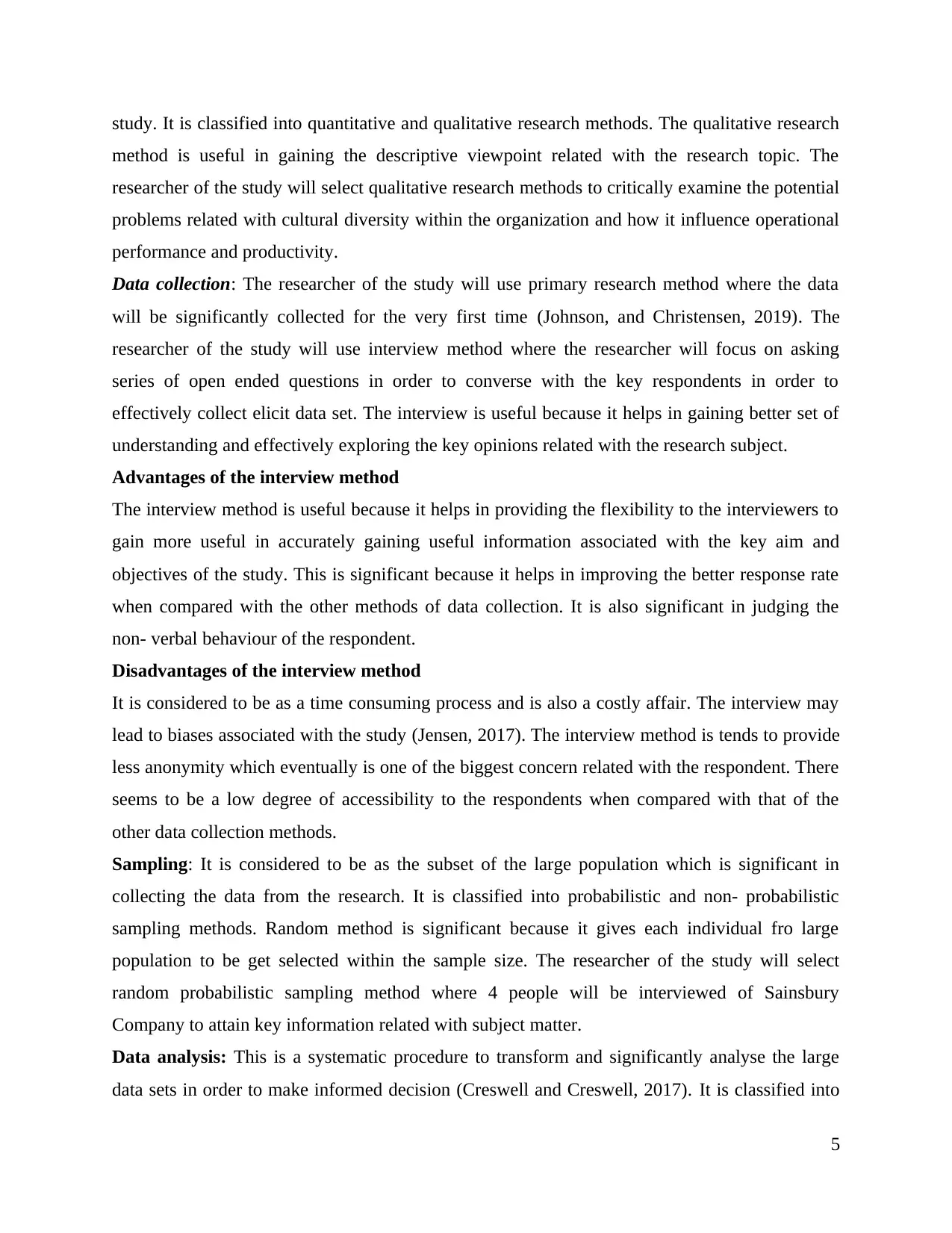
study. It is classified into quantitative and qualitative research methods. The qualitative research
method is useful in gaining the descriptive viewpoint related with the research topic. The
researcher of the study will select qualitative research methods to critically examine the potential
problems related with cultural diversity within the organization and how it influence operational
performance and productivity.
Data collection: The researcher of the study will use primary research method where the data
will be significantly collected for the very first time (Johnson, and Christensen, 2019). The
researcher of the study will use interview method where the researcher will focus on asking
series of open ended questions in order to converse with the key respondents in order to
effectively collect elicit data set. The interview is useful because it helps in gaining better set of
understanding and effectively exploring the key opinions related with the research subject.
Advantages of the interview method
The interview method is useful because it helps in providing the flexibility to the interviewers to
gain more useful in accurately gaining useful information associated with the key aim and
objectives of the study. This is significant because it helps in improving the better response rate
when compared with the other methods of data collection. It is also significant in judging the
non- verbal behaviour of the respondent.
Disadvantages of the interview method
It is considered to be as a time consuming process and is also a costly affair. The interview may
lead to biases associated with the study (Jensen, 2017). The interview method is tends to provide
less anonymity which eventually is one of the biggest concern related with the respondent. There
seems to be a low degree of accessibility to the respondents when compared with that of the
other data collection methods.
Sampling: It is considered to be as the subset of the large population which is significant in
collecting the data from the research. It is classified into probabilistic and non- probabilistic
sampling methods. Random method is significant because it gives each individual fro large
population to be get selected within the sample size. The researcher of the study will select
random probabilistic sampling method where 4 people will be interviewed of Sainsbury
Company to attain key information related with subject matter.
Data analysis: This is a systematic procedure to transform and significantly analyse the large
data sets in order to make informed decision (Creswell and Creswell, 2017). It is classified into
5
method is useful in gaining the descriptive viewpoint related with the research topic. The
researcher of the study will select qualitative research methods to critically examine the potential
problems related with cultural diversity within the organization and how it influence operational
performance and productivity.
Data collection: The researcher of the study will use primary research method where the data
will be significantly collected for the very first time (Johnson, and Christensen, 2019). The
researcher of the study will use interview method where the researcher will focus on asking
series of open ended questions in order to converse with the key respondents in order to
effectively collect elicit data set. The interview is useful because it helps in gaining better set of
understanding and effectively exploring the key opinions related with the research subject.
Advantages of the interview method
The interview method is useful because it helps in providing the flexibility to the interviewers to
gain more useful in accurately gaining useful information associated with the key aim and
objectives of the study. This is significant because it helps in improving the better response rate
when compared with the other methods of data collection. It is also significant in judging the
non- verbal behaviour of the respondent.
Disadvantages of the interview method
It is considered to be as a time consuming process and is also a costly affair. The interview may
lead to biases associated with the study (Jensen, 2017). The interview method is tends to provide
less anonymity which eventually is one of the biggest concern related with the respondent. There
seems to be a low degree of accessibility to the respondents when compared with that of the
other data collection methods.
Sampling: It is considered to be as the subset of the large population which is significant in
collecting the data from the research. It is classified into probabilistic and non- probabilistic
sampling methods. Random method is significant because it gives each individual fro large
population to be get selected within the sample size. The researcher of the study will select
random probabilistic sampling method where 4 people will be interviewed of Sainsbury
Company to attain key information related with subject matter.
Data analysis: This is a systematic procedure to transform and significantly analyse the large
data sets in order to make informed decision (Creswell and Creswell, 2017). It is classified into
5
Paraphrase This Document
Need a fresh take? Get an instant paraphrase of this document with our AI Paraphraser
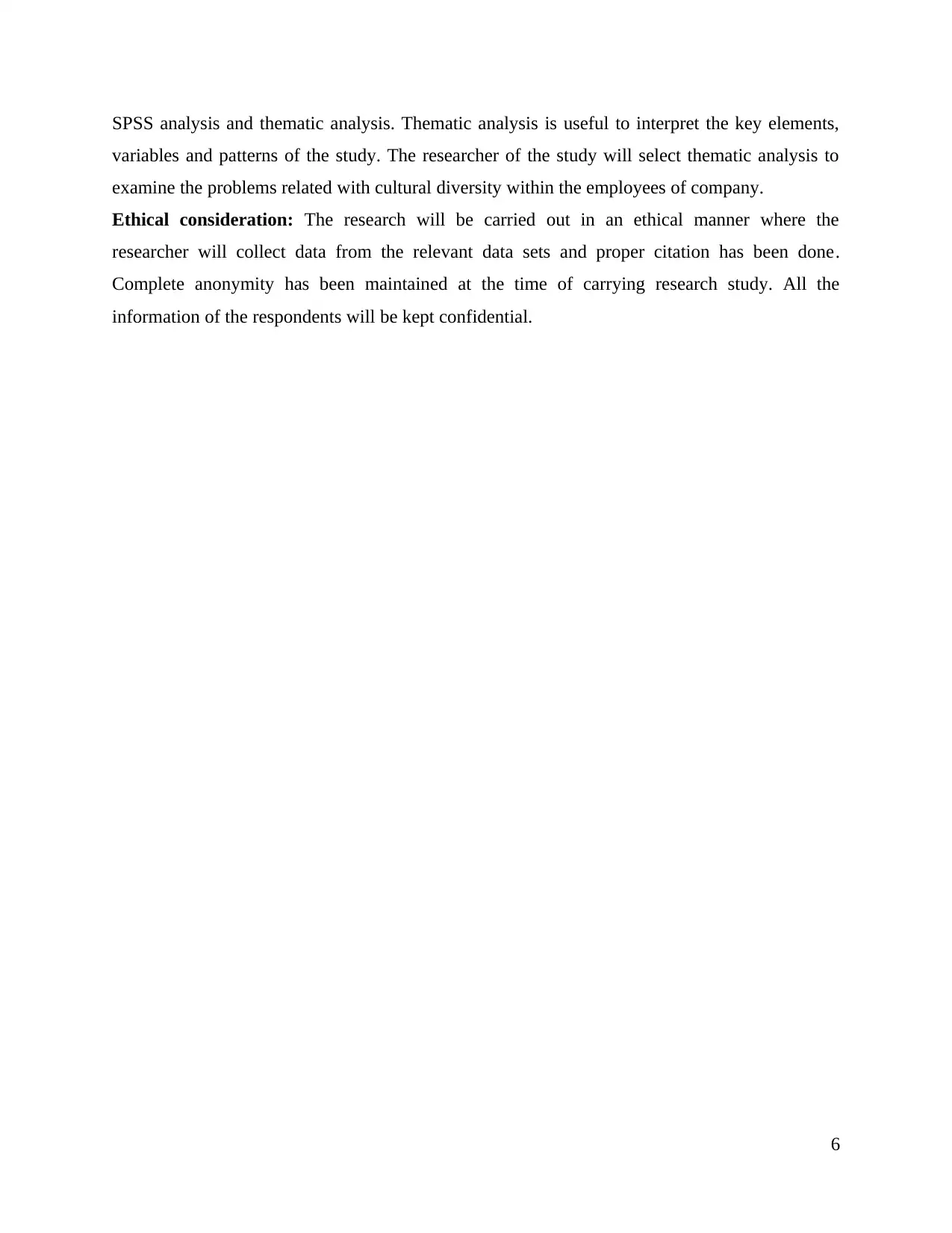
SPSS analysis and thematic analysis. Thematic analysis is useful to interpret the key elements,
variables and patterns of the study. The researcher of the study will select thematic analysis to
examine the problems related with cultural diversity within the employees of company.
Ethical consideration: The research will be carried out in an ethical manner where the
researcher will collect data from the relevant data sets and proper citation has been done.
Complete anonymity has been maintained at the time of carrying research study. All the
information of the respondents will be kept confidential.
6
variables and patterns of the study. The researcher of the study will select thematic analysis to
examine the problems related with cultural diversity within the employees of company.
Ethical consideration: The research will be carried out in an ethical manner where the
researcher will collect data from the relevant data sets and proper citation has been done.
Complete anonymity has been maintained at the time of carrying research study. All the
information of the respondents will be kept confidential.
6
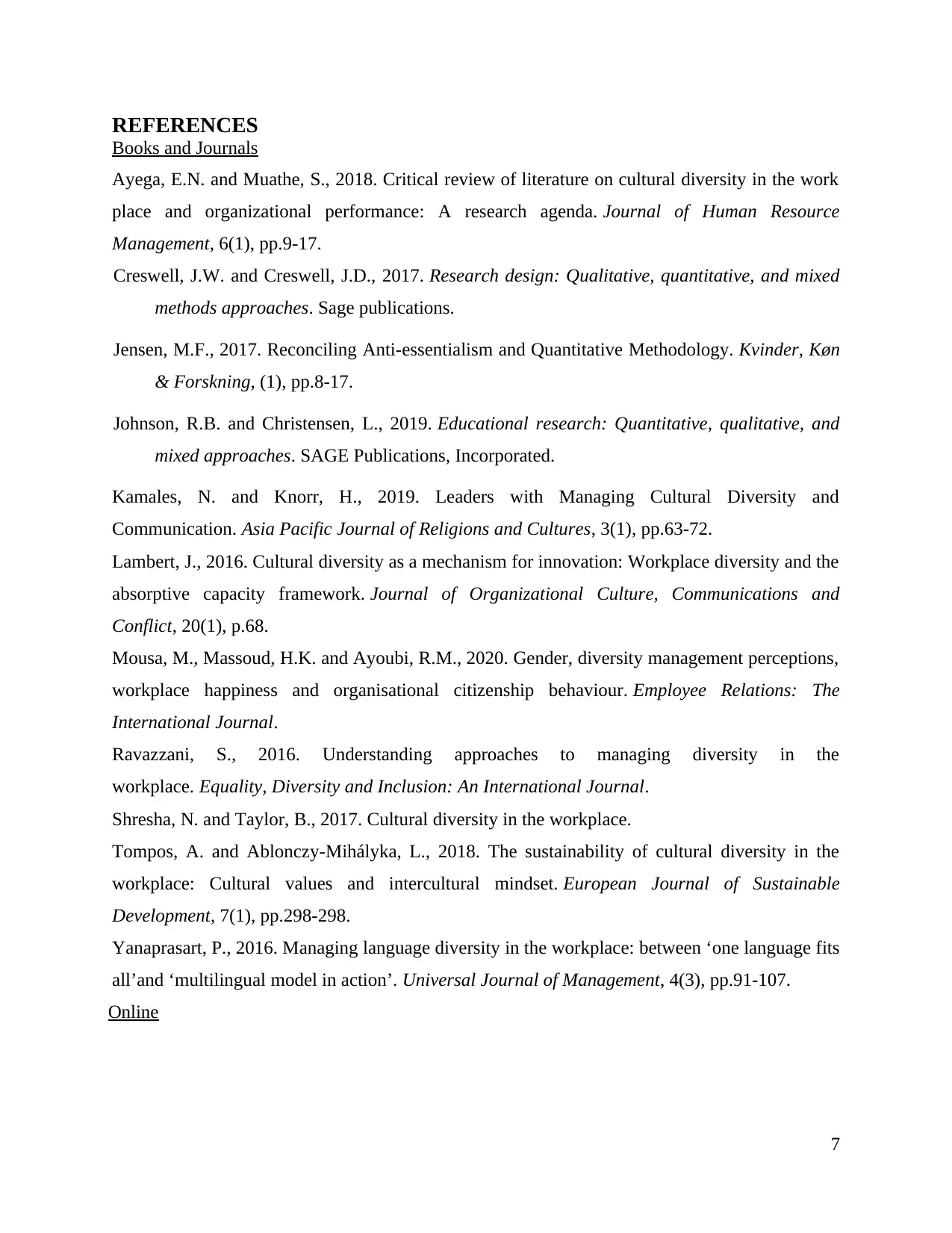
REFERENCES
Books and Journals
Ayega, E.N. and Muathe, S., 2018. Critical review of literature on cultural diversity in the work
place and organizational performance: A research agenda. Journal of Human Resource
Management, 6(1), pp.9-17.
Creswell, J.W. and Creswell, J.D., 2017. Research design: Qualitative, quantitative, and mixed
methods approaches. Sage publications.
Jensen, M.F., 2017. Reconciling Anti-essentialism and Quantitative Methodology. Kvinder, Køn
& Forskning, (1), pp.8-17.
Johnson, R.B. and Christensen, L., 2019. Educational research: Quantitative, qualitative, and
mixed approaches. SAGE Publications, Incorporated.
Kamales, N. and Knorr, H., 2019. Leaders with Managing Cultural Diversity and
Communication. Asia Pacific Journal of Religions and Cultures, 3(1), pp.63-72.
Lambert, J., 2016. Cultural diversity as a mechanism for innovation: Workplace diversity and the
absorptive capacity framework. Journal of Organizational Culture, Communications and
Conflict, 20(1), p.68.
Mousa, M., Massoud, H.K. and Ayoubi, R.M., 2020. Gender, diversity management perceptions,
workplace happiness and organisational citizenship behaviour. Employee Relations: The
International Journal.
Ravazzani, S., 2016. Understanding approaches to managing diversity in the
workplace. Equality, Diversity and Inclusion: An International Journal.
Shresha, N. and Taylor, B., 2017. Cultural diversity in the workplace.
Tompos, A. and Ablonczy-Mihályka, L., 2018. The sustainability of cultural diversity in the
workplace: Cultural values and intercultural mindset. European Journal of Sustainable
Development, 7(1), pp.298-298.
Yanaprasart, P., 2016. Managing language diversity in the workplace: between ‘one language fits
all’and ‘multilingual model in action’. Universal Journal of Management, 4(3), pp.91-107.
Online
7
Books and Journals
Ayega, E.N. and Muathe, S., 2018. Critical review of literature on cultural diversity in the work
place and organizational performance: A research agenda. Journal of Human Resource
Management, 6(1), pp.9-17.
Creswell, J.W. and Creswell, J.D., 2017. Research design: Qualitative, quantitative, and mixed
methods approaches. Sage publications.
Jensen, M.F., 2017. Reconciling Anti-essentialism and Quantitative Methodology. Kvinder, Køn
& Forskning, (1), pp.8-17.
Johnson, R.B. and Christensen, L., 2019. Educational research: Quantitative, qualitative, and
mixed approaches. SAGE Publications, Incorporated.
Kamales, N. and Knorr, H., 2019. Leaders with Managing Cultural Diversity and
Communication. Asia Pacific Journal of Religions and Cultures, 3(1), pp.63-72.
Lambert, J., 2016. Cultural diversity as a mechanism for innovation: Workplace diversity and the
absorptive capacity framework. Journal of Organizational Culture, Communications and
Conflict, 20(1), p.68.
Mousa, M., Massoud, H.K. and Ayoubi, R.M., 2020. Gender, diversity management perceptions,
workplace happiness and organisational citizenship behaviour. Employee Relations: The
International Journal.
Ravazzani, S., 2016. Understanding approaches to managing diversity in the
workplace. Equality, Diversity and Inclusion: An International Journal.
Shresha, N. and Taylor, B., 2017. Cultural diversity in the workplace.
Tompos, A. and Ablonczy-Mihályka, L., 2018. The sustainability of cultural diversity in the
workplace: Cultural values and intercultural mindset. European Journal of Sustainable
Development, 7(1), pp.298-298.
Yanaprasart, P., 2016. Managing language diversity in the workplace: between ‘one language fits
all’and ‘multilingual model in action’. Universal Journal of Management, 4(3), pp.91-107.
Online
7
⊘ This is a preview!⊘
Do you want full access?
Subscribe today to unlock all pages.

Trusted by 1+ million students worldwide

How to Build, Manage and Promote Workplace Diversity?. 2018. [ONLINE].
Available through< https://www.talentlyft.com/en/blog/article/246/how-to-build-manage-and-
promote-workplace-diversity>
8
Available through< https://www.talentlyft.com/en/blog/article/246/how-to-build-manage-and-
promote-workplace-diversity>
8
1 out of 10
Related Documents
Your All-in-One AI-Powered Toolkit for Academic Success.
+13062052269
info@desklib.com
Available 24*7 on WhatsApp / Email
![[object Object]](/_next/static/media/star-bottom.7253800d.svg)
Unlock your academic potential
Copyright © 2020–2025 A2Z Services. All Rights Reserved. Developed and managed by ZUCOL.





